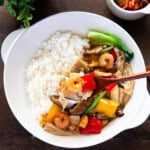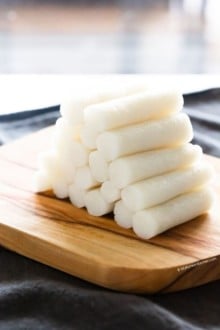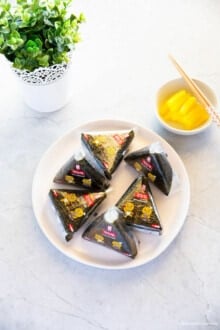Try this Korean Chinese-style mushroom rice bowl recipe. It’s loaded with mushrooms, colorful crunchy vegetables, and covered with a savory sauce. It’s easy and delicious!
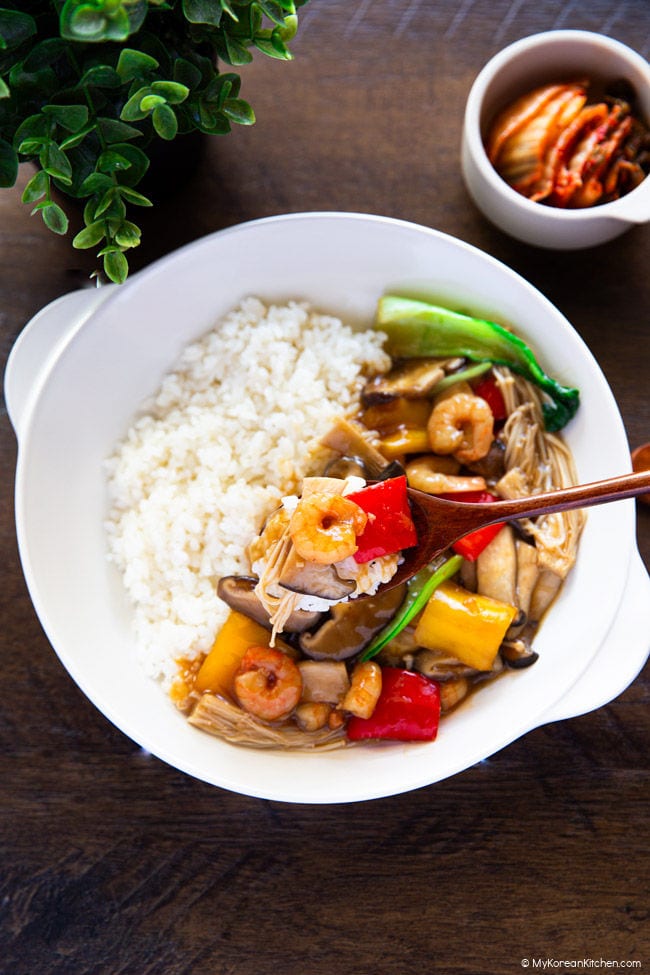
Why I Love This Recipe
Beoseot Deopbap (버섯 덮밥) is a Korean dish that translates to ‘Mushroom Rice Bowl.’ It’s a simple yet flavorful meal consisting of steamed rice topped with a variety of sautéed mushrooms, often mixed with other crunchy vegetables.
This recipe includes shrimp, but feel free to add your choice of meat to add more texture and flavor, which will wonderfully complement the mushrooms. The mushrooms and other main ingredients are seasoned with garlic, soy sauce, oyster sauce, and additional ingredients to enhance their flavors.
Korean mushroom rice is often sold in Korean-Chinese restaurants, and this recipe is based on a restaurant version from my second hometown in Korea I enjoyed many years ago; so, it might differ from what’s available nowadays.
As an example, I recently tried it at a Korean-Chinese restaurant here in Australia, and I found it tasted more closely to ‘Mongolian beef,’ but with king oyster mushrooms, baby bok choy, onion, bell peppers, and broccoli, and without meat! I prefer my second hometown version as it has a more subtle yet rich umami taste and an abundance of other vegetables, making it more filling.
This dish is comforting and easy to make, suitable for vegetable lovers, and can be adapted to suit vegetarian or vegan diets. Give it a try!
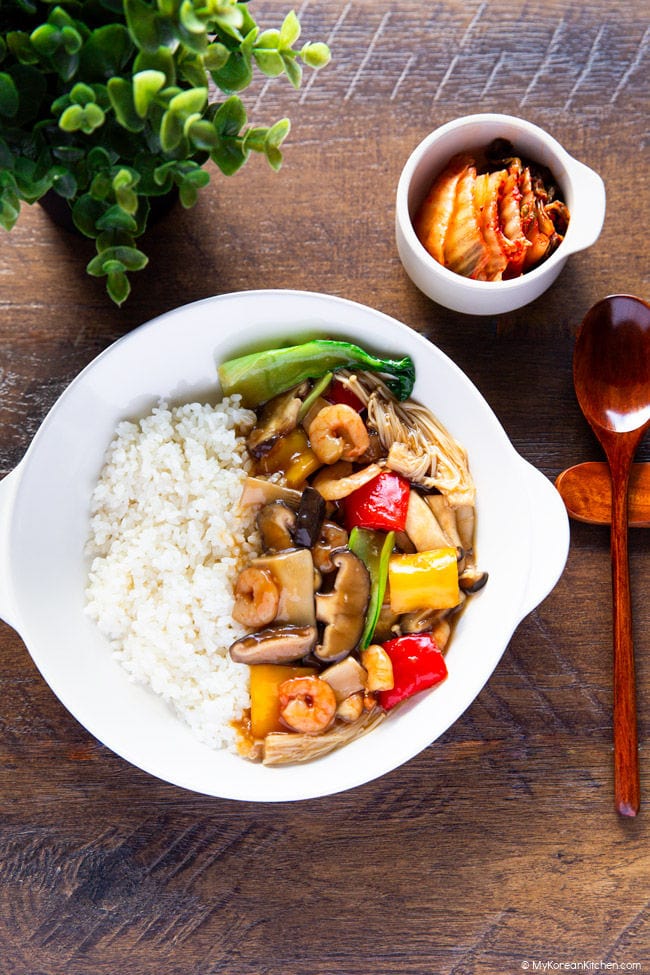
Ingredients
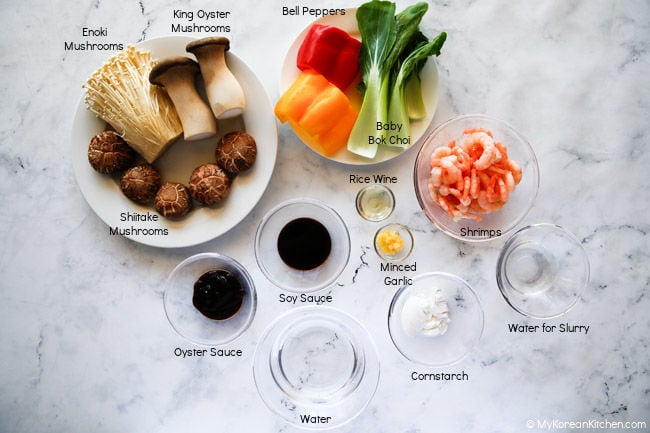
Main
- 200g / 7.1 ounces shrimp or prawn – shelled and de-veined (Using frozen shrimps that are already shelled and cleaned makes the cooking very easy! Or use 300g / 10.6 ounces beef strips if you want more meaty flavor)
- 60g / 2.1 ounces red bell pepper – washed, seeded, and diced into medium-sized chunks
- 60g / 2.1 ounces yellow pepper – washed, seeded, and diced into medium-sized chunks
- 75g / 2.6 ounces shiitake mushrooms – gently rinsed and thinly sliced
- 150g / 5.3 ounces king oyster mushrooms – gently rinsed and thinly sliced
- 65g / 2.3 ounces baby bok choy – washed, cut into medium sized pieces
- 150g / 5.3 ounces enoki mushrooms – gently cleaned, stems removed, and separated
- steamed rice for 4 servings
Sauce
- 1/2 Tbsp rice wine (mirin)
- 1/2 Tbsp minced garlic
- 2 Tbsp soy sauce (I used regular kikkoman soy sauce.)
- 2.5 Tbsp oyster sauce (I used MSG-free sauce; if using sauce with MSG, you may want to reduce the amount slightly.)
- 1 cup water
- 2 Tbsp cornstarch
- 2 Tbsp water
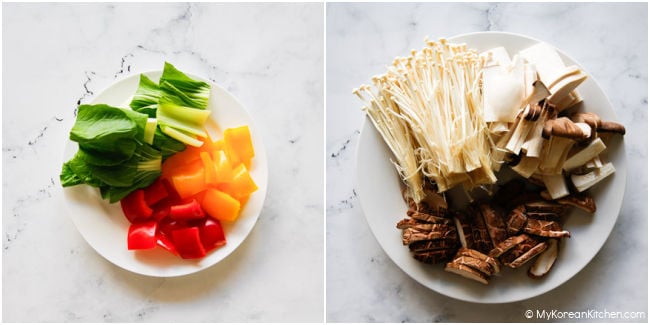
Tips
- Vegetables: Other popular vegetables you could use include broccoli, onions, carrots, and snow peas.
- Mushrooms: For the best texture and flavor, go for fresh mushrooms. Using old or heavily bruised ones can bring out strong or earthy flavors, which might alter the overall taste of your dish. When selecting mushrooms, prioritize options such as king oyster, shiitake, and enoki for their superior texture. While button mushrooms are acceptable, the former varieties are better suited for this dish, based on my numerous testing.
- Protein: If you’re not into shrimp, you can use other meats. Beef, in particular, goes very well. I usually buy stir-fry beef for this, or have used rib-eye fillet, which also works really well.
How to Make Korean Mushroom Rice Bowl
1. Rinse the shrimp under cold water in a bowl, then marinate with rice wine. Set aside to allow the flavors to meld.
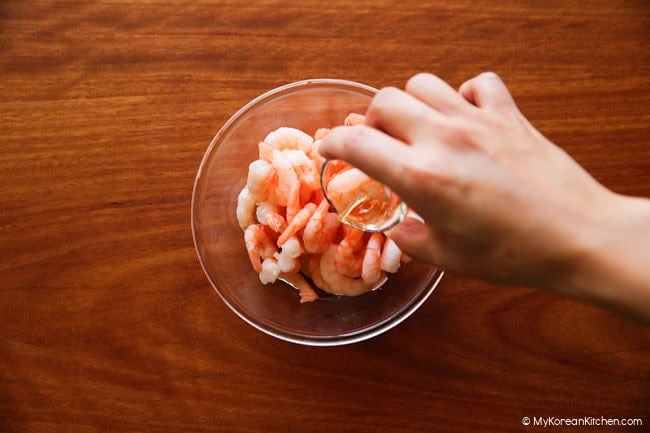
2. Preheat a pan over low heat and coat lightly with cooking oil. Add minced garlic to the pan and sauté until lightly golden, making sure to keep the heat low to prevent burning. Stir often.
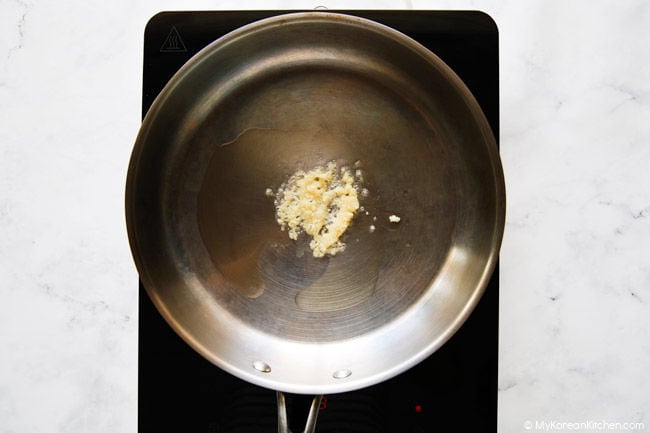
3. Add the bell peppers to the pan, stirring often, and cook for 2 minutes or until they soften slightly.
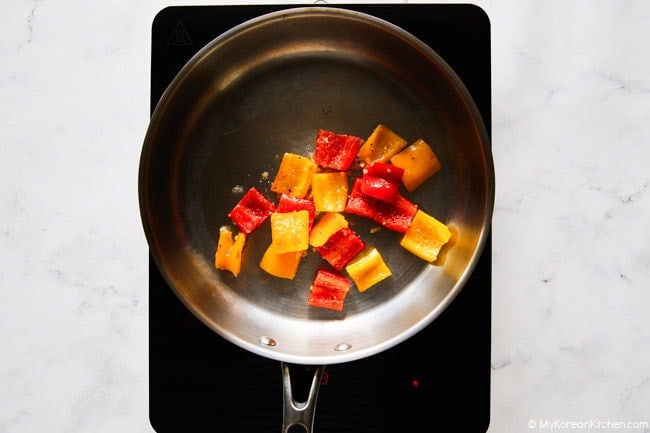
4. Add the marinated shrimp, shiitake mushrooms, and king oyster mushrooms to the pan. Increase the heat to medium, and stir well for even cooking.
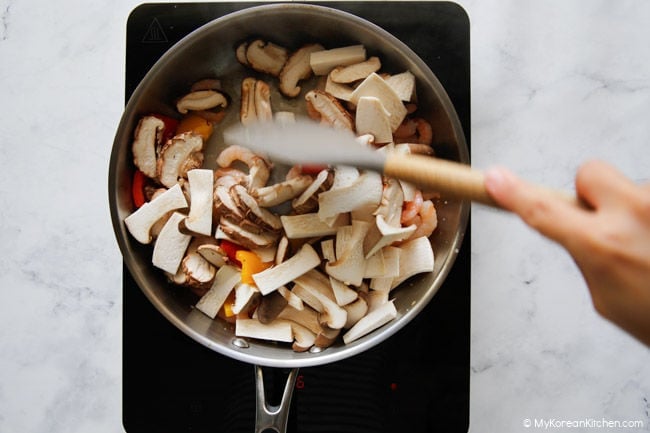
5. Add the soy sauce and oyster sauce, stirring well to ensure all ingredients are evenly coated. Cook for 2 minutes to allow the flavors to meld together.
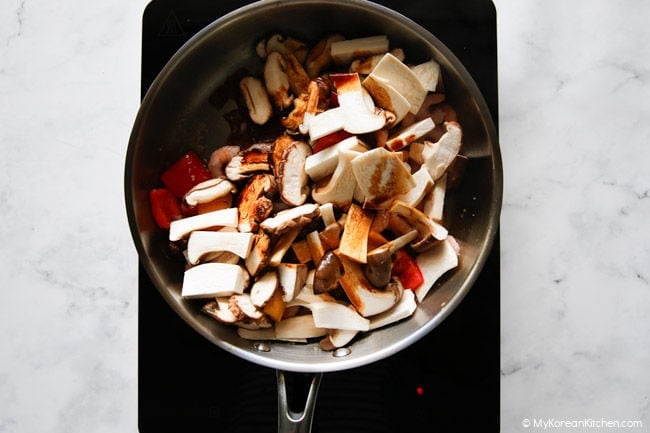
6. Add the bok choy and stir well. Add 1 cup of water and increase the heat to bring the mixture to a boil. Let it boil for 1 minute.
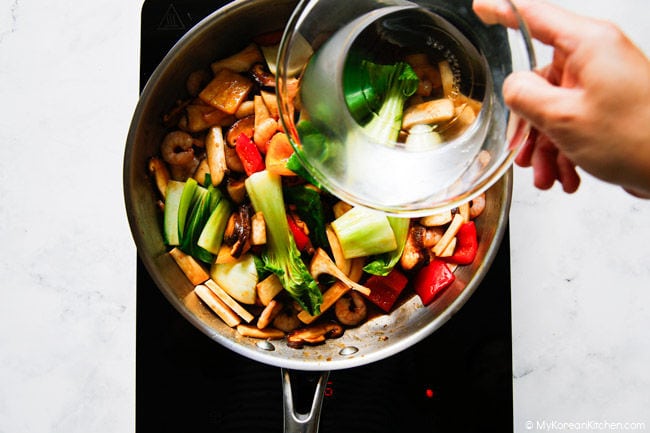
7. Add enoki mushrooms and mix well with the other ingredients. Cook for an additional 1-2 minutes, or until the enoki mushrooms are tender.
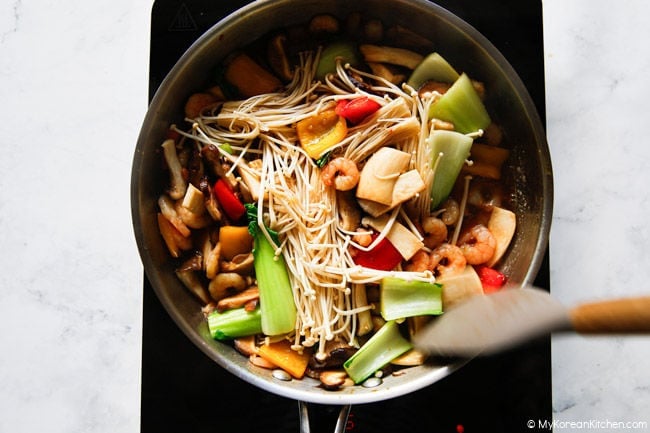
8. Meanwhile, mix cornstarch and water in a small bowl until well combined. Gradually stir the slurry into the pan and cook for about 20 seconds, or until the sauce reaches your desired thickness.
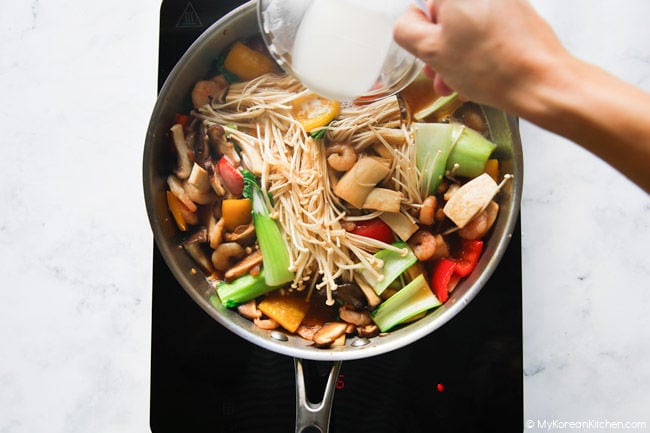
9. Serve it immediately on a bed of cooked rice.

How to Store Leftovers
Leftover mushroom rice can be stored in an airtight container in the fridge for 3 to 4 days and reheated in the microwave. It can also be frozen for up to 1 month.
Alternatively, you can store the mushrooms and saucy vegetable components separately from the rice, a method I personally prefer, so that I can serve them with freshly made rice.
More One-Bowl Recipes You Will Love
Love Korean food? Explore our site for more authentic Korean recipes including how to create a perfect Korean BBQ at home or other easy Korean recipes. Also, never miss a new recipe by subscribing to our newsletter, and join us in celebrating Korean cuisine!
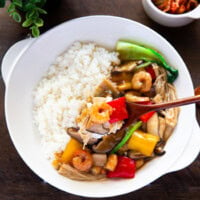
Mushroom Rice Bowl (Beoseot Deopbap)
Ingredients
MAIN
- 200 g shrimps or prawn, (7.1 ounces) shelled and deveined (Using frozen shrimps that are already shelled and cleaned makes the cooking very easy! Or use 300g / 10.6 ounces beef strips if you want more meaty flavor)
- 60 g red bell pepper (2.1 ounces), washed, seeded, and diced into medium-sized chunks
- 60 g yellow bell pepper (2.1 ounces), washed, seeded, and diced into medium-sized chunks
- 75 g shiitake mushrooms (2.6 ounces), gently rinsed and thinly sliced
- 150 g king oyster mushrooms (5.3 ounces), gently rinsed and thinly sliced
- 65 g baby bok choy (2.3 ounces), washed, cut into medium sized pieces
- 150 g enoki mushrooms (5.3 ounces), gently cleaned, stems removed, and separated
- 4 cups steamed rice
Instructions
- Rinse the shrimp under cold water in a bowl, then marinate with rice wine. Set aside to allow the flavors to meld.
- Preheat a pan over low heat and coat lightly with cooking oil. Add minced garlic to the pan and sauté until lightly golden, making sure to keep the heat low to prevent burning. Stir often.
- Add the bell peppers to the pan, stirring often, and cook for 2 minutes or until they soften slightly.
- Add the marinated shrimp, shiitake mushrooms, and king oyster mushrooms to the pan. Increase the heat to medium, and stir well for even cooking.
- Add the soy sauce and oyster sauce, stirring well to ensure all ingredients are evenly coated. Cook for 2 minutes to allow the flavors to meld together.
- Add the bok choy and stir well. Add 1 cup of water and increase the heat to bring the mixture to a boil. Let it boil for 1 minute.
- Add enoki mushrooms and mix well with the other ingredients. Cook for an additional 1-2 minutes, or until the enoki mushrooms are tender.
- Meanwhile, mix cornstarch and water in a small bowl until well combined. Gradually stir the slurry into the pan and cook for about 20 seconds, or until the sauce reaches your desired thickness.
- Serve it immediately on a bed of cooked rice.
Notes
- Vegetables: Other popular vegetables you could use include broccoli, onions, carrots, and snow peas.
- Mushrooms: For best texture and flavor, go for fresh mushrooms. Using old or heavily bruised ones can bring out strong or earthy flavors, which might alter the overall taste of your dish. When selecting mushrooms, prioritize options such as king oyster, shiitake, and enoki for their superior texture. While button mushrooms are acceptable, the former varieties are better suited for this dish, based on my numerous testing.
- Protein: If you’re not into shrimp, you can use other meats. Beef, in particular, goes very well. I usually buy stir-fry beef for this, or have used rib-eye fillet, which also works really well.
- Storage: Leftover mushroom rice can be stored in an airtight container in the fridge for 3 to 4 days and reheated in the microwave. It can also be frozen for up to 1 month. Alternatively, you can store the mushrooms and saucy vegetable components separately from the rice, a method I personally prefer, so that I can serve them with freshly made rice.
Nutrition Info (per serving)
The nutrition information shown is an estimate provided by an online nutrition calculator. It should not be considered a substitute for a professional nutritionist’s advice.
